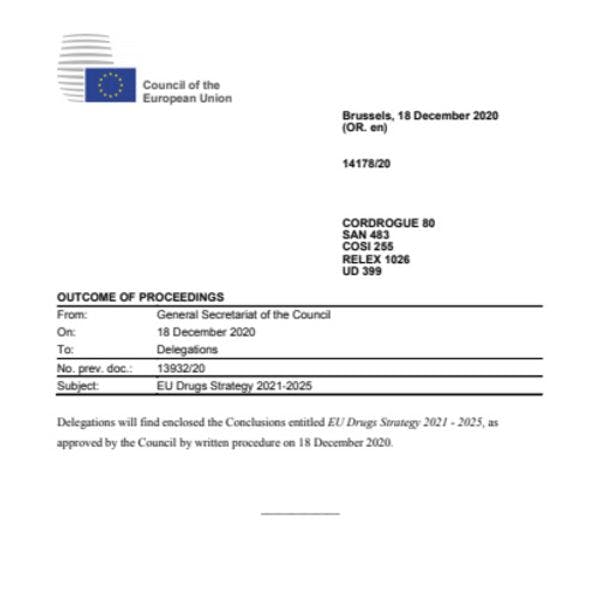Estrategia sobre drogas de la UE para el período 2021-2025
El Consejo de la Unión Europea aprueba la nueva Estrategia del bloque regional, basada en la reducción de la oferta, reducción de la demanda, y atención de los daños relacionados con drogas. Más información, en inglés, está disponible abajo.
The strategy aims to ensure a high level of health promotion, social stability and security and contribute to awareness raising. On the basis of this strategy, the Council will prepare an action plan which will set out concrete measures to achieve these priorities.
With this strategy, the EU and its member states reaffirm their commitment to an approach which is based on evidence, comprehensive and balanced between demand and supply reduction of drugs, with the preservation of human rights at its core. At the same time, this strategy uses the lessons learned from the COVID-19 crisis in the drugs area and takes a future-oriented approach, promoting research, innovation and foresight to respond more effectively to increasing challenges and to anticipate them.
Under drug supply reduction/enhanced security the strategy targets all aspects of the illicit drug market, and includes the prevention of, dissuasion from and disruption of drug related crime, in particular organised crime, through judicial and law enforcement cooperation, intelligence, interdiction, confiscation of criminal assets, investigations and border management. This priority area has been further enhanced as compared to the 2013-2020 strategy, to respond to the challenging developments in European drug markets. These are characterised by a high availability of various types of drugs, ever larger seizures, increasing use of violence and huge profits, as well as the use of social media platforms, apps and the internet and darknet for illicit drug trafficking. Such features have not faded during the COVID-19 crisis, to the contrary.
The drug demand reduction policy area consists of a range of mutual reinforcing measures including prevention, early detection and intervention, counselling, treatment, rehabilitation, social reintegration and recovery. Such action needs to be appropriate to the local social context and the needs of the target population, be informed by scientific evidence and be safe and effective. It needs to be developed through the close collaboration of a number of health and social support services. The COVID-19 crisis has further revealed the need to ensure continuity of these actions.
A new, dedicated chapter has been added on addressing drug related harm. This section includes measures and policies to prevent or reduce the possible health and social risks and harm for users, for society and in prison settings. It covers aspects such as reducing the prevalence and incidence of drug-related infectious diseases, preventing overdoses and drug-related deaths and providing alternatives to coercive sanctions.
The strategy also identifies three cross-cutting themes in support of the policy areas:
- international cooperation: enhancing the role of the EU as a global broker for a people-centred and human rights-oriented drug policy through cooperation with third countries, regions and international organisations, while strengthening the commitment to development-orientated drug policies and alternative development measures.
- research, innovation and foresight: providing the EU and member states with the necessary comprehensive research and foresight capacities to address drug challenges in a more agile and proactive manner, increasing preparedness to respond to future challenges.
- coordination, governance and implementation: ensuring optimal implementation of the strategy, including via the key action of the European Monitoring Centre for Drugs and Drug Addiction (EMCDDA) and of Europol, involving civil society and providing adequate resources at EU and national level to achieve this.
